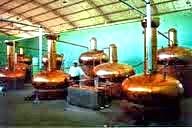 “It is produced in over 20 of the 27 states in Brazil. You have different types of sugar cane used. There are then the different types of wood used in the ageing process and on top of that, you have blends of cachaça that were aged in different woods. The world of cachaça is as rich and as varied as Brazil itself.”
“It is produced in over 20 of the 27 states in Brazil. You have different types of sugar cane used. There are then the different types of wood used in the ageing process and on top of that, you have blends of cachaça that were aged in different woods. The world of cachaça is as rich and as varied as Brazil itself.” The
major difference between Cachaca and Rum is that rum is usually
made from molasses, a by-product from refineries that boil the cane
juice to extract as much sugar crystal as possible, while cachaça is made from
fresh sugarcane juice that is fermented and distilled. As
some rums are also made by this process, cachaça is also known as Brazilian
rum.
However, the United States recognized Cachaça as a distinctive Brazilian
product by signing an agreement with Brazil in which Ron Kirk and Brazil's Fernando Pimetel were involved, hopefully this
is likely to drop the usage of the expression "Brazilian Rum".
The
major difference between Cachaca and Rum is that rum is usually
made from molasses, a by-product from refineries that boil the cane
juice to extract as much sugar crystal as possible, while cachaça is made from
fresh sugarcane juice that is fermented and distilled. As
some rums are also made by this process, cachaça is also known as Brazilian
rum.
However, the United States recognized Cachaça as a distinctive Brazilian
product by signing an agreement with Brazil in which Ron Kirk and Brazil's Fernando Pimetel were involved, hopefully this
is likely to drop the usage of the expression "Brazilian Rum".  The history of Brazil's National Spirit is interesting see it really did not start in Brazil.
“Sugar production was mostly switched from Madeira Island to Brazil by the Portuguese in the 16th century.
In Madeira Aguardente de
cana is made by distilling sugar cane. The pot stills that make Aguardente de
cana in Madeira were brought to Brazil to make what today is also called
Cachaça. “
The history of Brazil's National Spirit is interesting see it really did not start in Brazil.
“Sugar production was mostly switched from Madeira Island to Brazil by the Portuguese in the 16th century.
In Madeira Aguardente de
cana is made by distilling sugar cane. The pot stills that make Aguardente de
cana in Madeira were brought to Brazil to make what today is also called
Cachaça. “
The
distillation process dates back to 1532, when one of the Portuguese colonizers
brought the first cuttings of sugar cane over to Brazil from Madeira. Cachaça is mostly produced in Brazil, where,
according to 2007 figures, 1.5 billion liters (390 million gallons) are
consumed annually, compared with 15 million liters (4.0 million gallons)
outside the country. It is typically
between 38% and 48% abv. When it is homemade it can be as strong as
the distiller wants. I find it interesting that up to six grams per litre of sugar may be added for flavor."

Caipirinha
·
Juice of ½ Lime
·
2 Teaspoon of Fine Sugar
·
2 oz. Cachaca
Place Cachaca, lime juice and sugar in a shaker with ice and shake until chilled. Strain into a rocks glass with a sugar in the raw rim. Garnish with lime wheel.The Caipirinha can be made with almost any juicy fruit instead of the lime, many version which are found through out Brazil and the rest of the world. Let your imagination run and enjoy the fun of the varieties of Caipirinha you can create.
